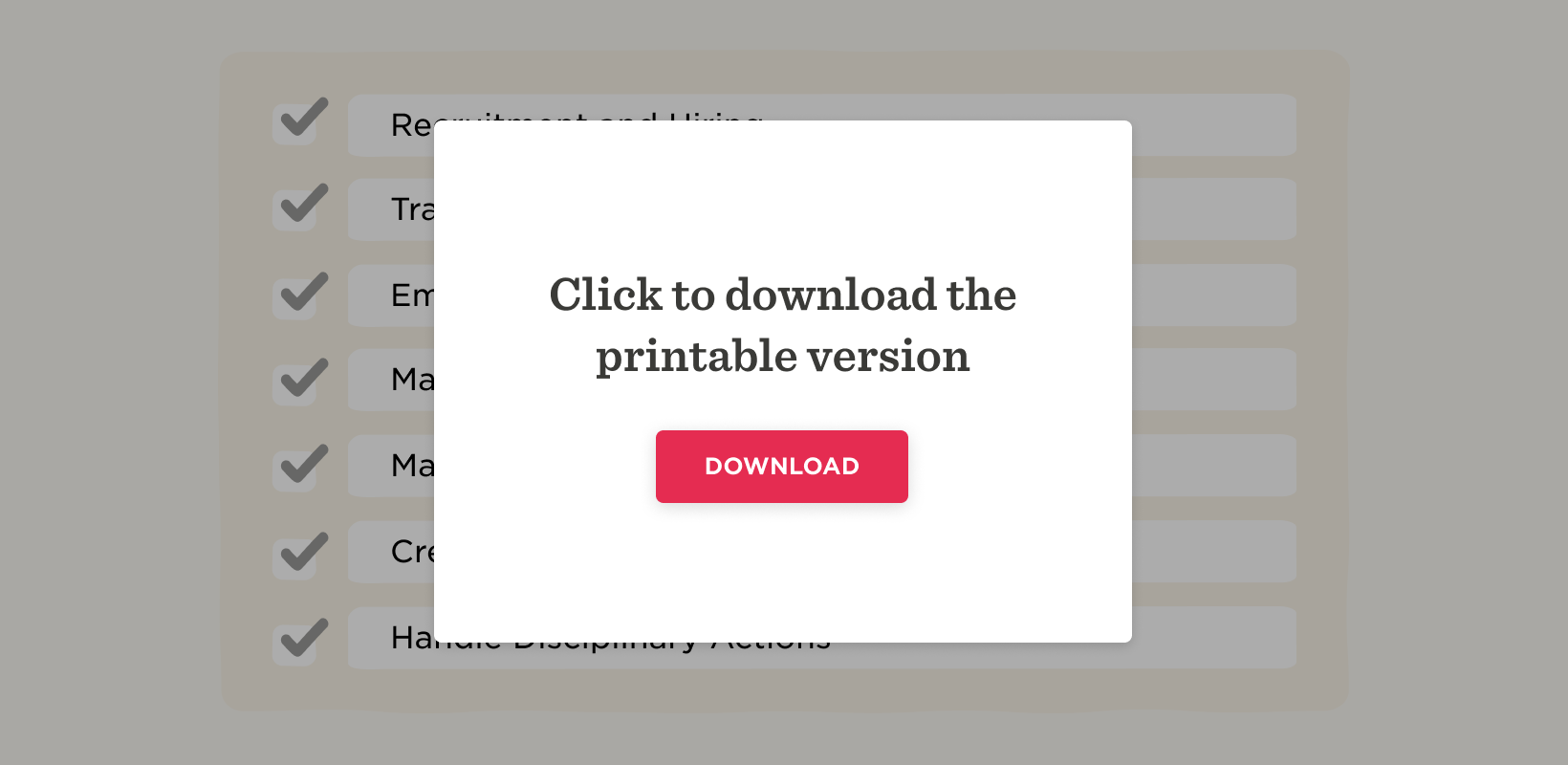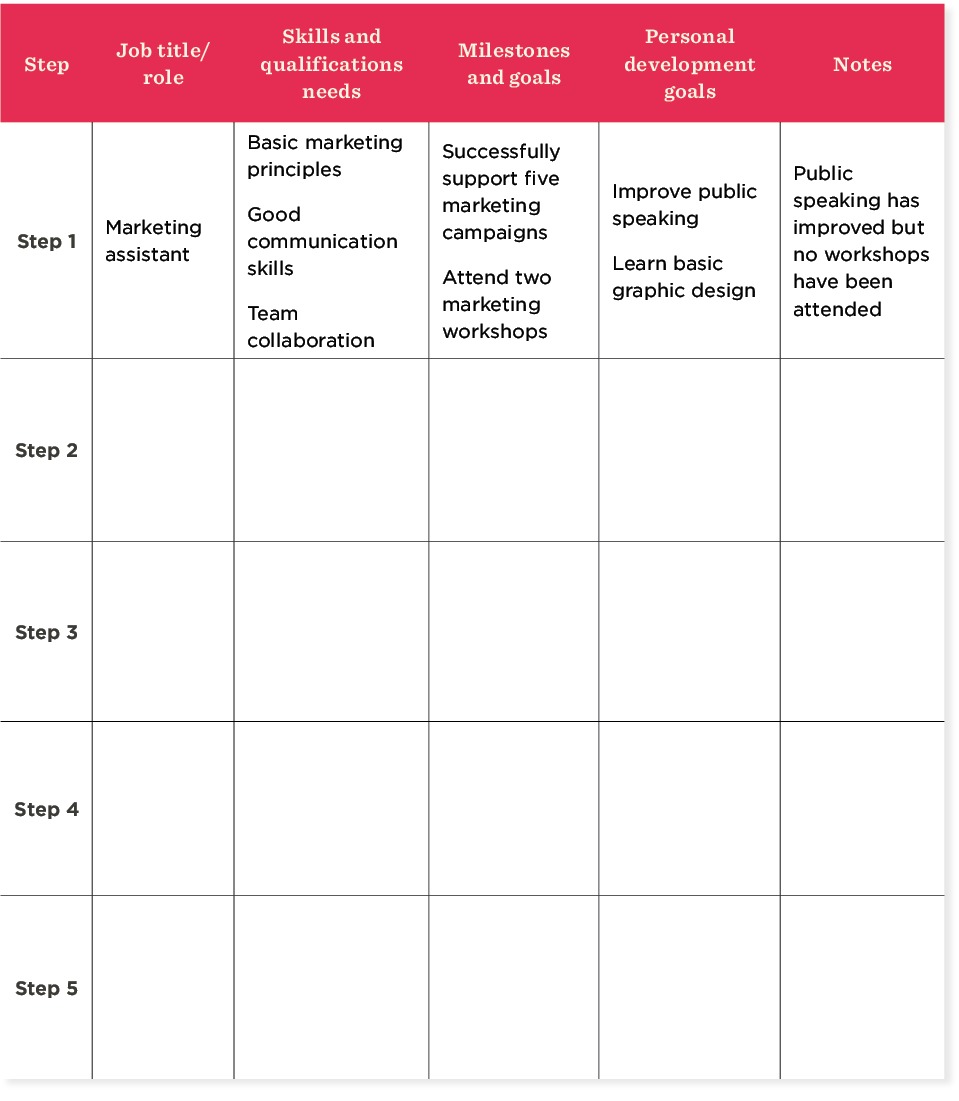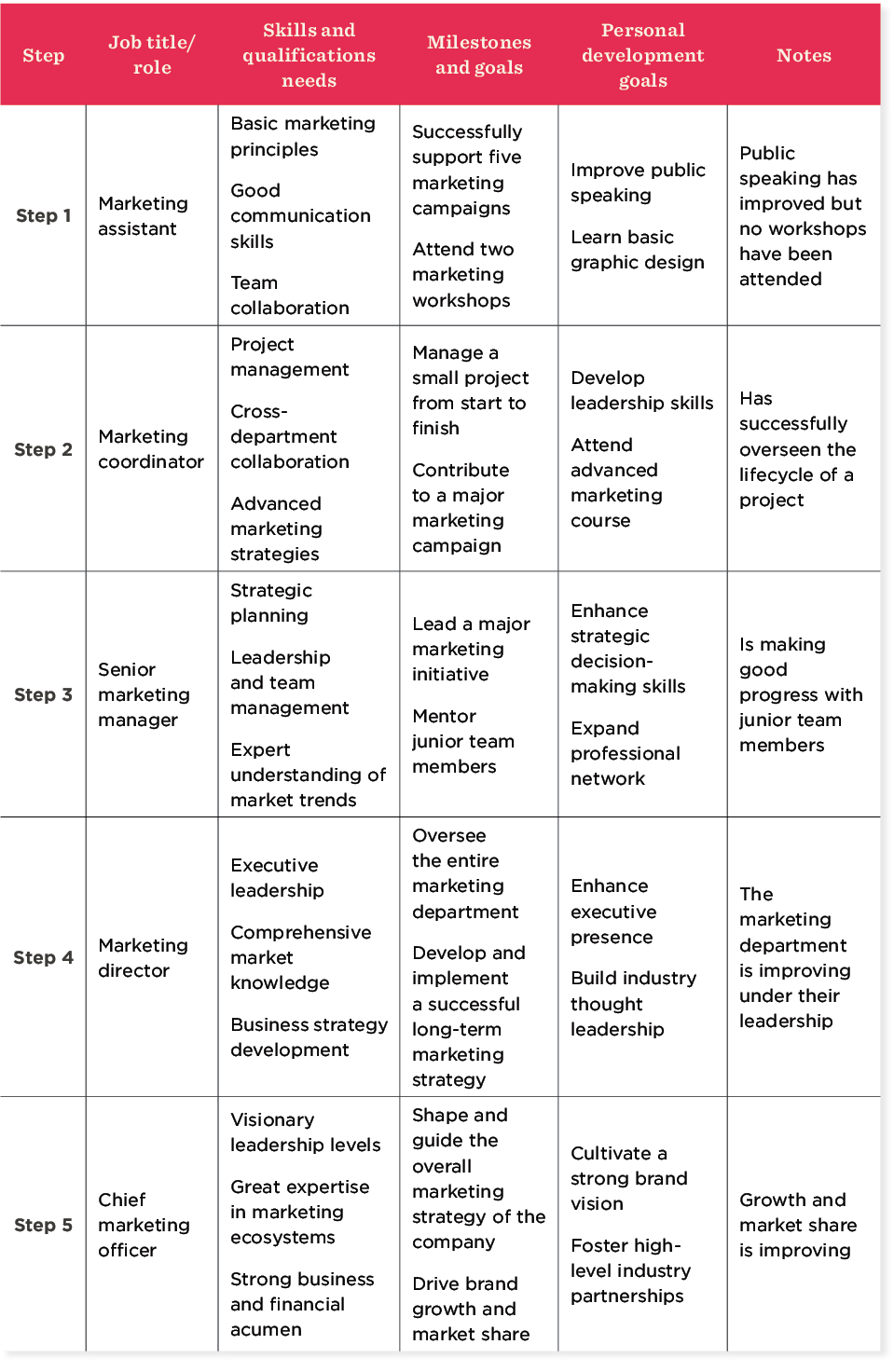In the ups and downs of the modern world of work, navigating a career path can feel like being stuck in a maze. With technological advancements like artificial intelligence, economic shifts, and cultural changes, it may feel difficult to make a career plan—but it’s more crucial than ever to map out the future.
Organizations and individuals can use career path templates to create structure and clarity in an otherwise uncertain professional landscape.
Let’s take a look at how organizations can use strategic career pathing to give team members peace of mind and something to strive toward.

<<Download and print this career path template to map your people’s careers.>>
What is a career path?
A career path provides guidance on how to progress through a series of roles within a specific profession. It details the job titles, necessary skills, and ongoing experiences team members will need to move forward on a given path. Organizations can create a career path to give team members an overview of their options as they progress with the company.
Providing a clear development roadmap helps companies motivate their team members and drive overall employee satisfaction. With a clear direction and an inspiring journey ahead, team members can target their learning and involvement toward their crystal-clear goals.
Career path stages
Every career path looks different, but most of them follow these core stages:
- Exploration: Some team members may follow a straightforward path, while others explore several roles to find what’s right for them. The exploration phase may involve a few months of research before applying for jobs. People might also explore different pathways multiple times throughout their careers. Organizations can encourage the exploration phase to ensure team members follow a career path aligned with their unique skills and passions.
- Education: Team members enter the education stage when they join the workforce or a new department. This stage includes working with mentors, completing necessary on-the-job training and certifications, and sitting in on broader team meetings to understand key objectives. A strong employee onboarding experience helps new joiners move through this phase smoothly.
- Starting point: Organizations can support team members in early career stages by providing continuous learning opportunities, offering mentorship programs, developing leadership skills, and paving the way for career advancement. Communicate with team members about their career path’s next steps and clarify which experiences and skills will help them move forward. When you prioritize employee enablement at this stage, you can help team members reach their full potential and positively impact the business.
- Step up: At this stage, team members start to take on more responsibilities and may begin to lead projects or small teams. Organizations can support them by offering advanced training and leadership development programs and providing regular feedback and clear communication about career advancement opportunities.
- Mid-career: People spend the majority of their careers in the mid-career stage. At this stage, they hone their collaborative skills, mentor junior team members, and take on managerial roles. They help fill operational gaps, set goals for the next stage of their careers, and determine key initiatives with higher management.
- Late career: In the late stage of the career path, team members may hold titles including Director, VP, or Executive. The team member has accumulated many years of meaningful experience. They may have impactful ideas to share and an influential view of long-term goals within the organization.
- Retirement and legacy: As team members prepare to retire, they might spend their time sharing strategic insights and supporting team members in earlier career stages. They can empower others to step into their shoes and may take on a teaching role or strategic advisory position. They can exit smoothly knowing they’ve laid the foundation for growth and prosperity in the organization.
No matter what stages you’re currently helping your people navigate, take a look at a career path to help guide your goals and measure your success as you progress.
What is a career path template?
Companies use career path templates to lay out potential career progressions for people within the organization. You can use them to provide clarity and direction for your people and give them a motivating picture of how they can progress in their careers.
Benefits of a career path template include:
- Boosting engagement and motivation. When people envision a clear future within their organization, they bring commitment and enthusiasm to their day-to-day activities. Actively investing in their career development shows them you care about their future as much as they do.
- Helping to identify training and development needs. Organizations can use career path templates to pinpoint which skills and training team members need to progress. This helps clarify goals and allows for targeted employee development initiatives.
- Aiding in succession planning and talent retention. Preparing people for potential future roles ensures you have a continuous flow of qualified internal candidates. This helps boost retention, fill skills gaps, and reduce the cost and hassle of external hiring.
<<Download and print this career path template to map your people’s careers.>>
HR managers can also leverage development plan templates when crafting career paths for their people. Organizations can use career path and development plan templates to identify skills gaps, align individual career goals with the company’s objectives, and support mutual growth and success.
Types of career paths
Many team members won’t follow a linear path throughout their careers. Organizations can consider various career paths to support their diverse workforce and ensure everyone can grow and succeed.
Personal vs. operational career paths
A career path looks different depending on whether you view it from a personal or operational perspective. Operational needs are fairly predictable. People are not.
Operational career paths map the expected roles that someone in a specific team will hold over time. For example, an operational career path may go from HR intern to HR coordinator to HR director to Chief People Officer.
A personal career path can pivot, meander, and involve breaks or interruptions. By making a strong and supportive company culture a top priority, organizations can retain top talent even when career paths move outside their original department.
Knowledge-based vs. skill-based career paths
Organizations or industries using knowledge-based career paths assign promotions and raises based on new certifications, degrees, or advanced training. For example, teachers in some United States School districts can earn a higher salary by earning additional university-level credits.
Other industries move team members forward on their career path when they demonstrate skill mastery. For example, a marketing coordinator might earn a promotion to marketing manager by demonstrating a deep understanding of revenue-generating campaigns.
Organizations can offer workshops, learning and development programs, and new work experiences to help team members hone their skills and advance their careers.
Why are career paths important?
Taking time to develop a detailed career path for each department and role offers numerous benefits.
Increased employee motivation and engagement
Organizations thrive when people are fully engaged and empowered in their work. Career paths foster a sense of ownership and forward motion, motivating team members to learn and show up as the best version of themselves.
Better talent and workforce management
Career paths give team members a high-level view of their future journey while providing managers with a clear structure for development. Leaders can use this to improve talent management and workforce planning.
Reduced employee turnover
Talented professionals seek new career opportunities because they don’t see a clear path at their current workplace. Keep your top talent by ensuring each team member knows how to advance in their career path within the company.
Offer opportunities to help them grow their skills and provide a clear guide for raises and promotions along their path so they can directly see the results of their hard work.
How does career pathing motivate employees?
Many people will have an eye on their futures. With career ambitions and goals at the forefront of your team members’ minds, career pathing can play a critical role in motivation.
Organizations can make people feel considered and valued by helping them understand the trajectory of their careers. When you provide insight into their professional future, they can properly envision their growth within your company.
Organizations can share this foresight to improve key HR metrics such as job satisfaction, turnover rates, and even productivity.
Let’s take a look at some more ways career pathing can help motivate your people:
Visibility
Having clear insight into different potential career opportunities can empower your team members to visualize their futures as a part of your organization. This transparency helps to set realistic and achievable career goals and reduces uncertainty about their journey.
Achievement
Including defined milestones in a career path template fosters a sense of accomplishment for your people. As they periodically reach these milestones, they feel a tangible sense of accomplishment and progress, which can further motivate them for the next stages of their career.
Growth
Career pathing presents the chance for both personal and professional development by encouraging people to learn new skills and expand their knowledge base. This helps to contribute to their overall career growth and improves their adaptability in an ever-evolving work environment.
Recognition
Developing and implementing a career pathing strategy sends a clear message to your people that you value and respect them and take their aspirations seriously. This sense of recognition can boost morale and increase people’s loyalty toward your organization.
Free career path template
To kick-start the implementation of your own career pathing system, we’ve created this downloadable career path template.
We designed it to be user-friendly, easily customizable, and flexible enough to reflect a wide range of specific career progression paths—so it’s readily accessible to fit the unique requirements of your people and your organization.
What makes a good career path template?
A good career path template includes all of the details you need to guide team members through each step of their professional growth. You can adapt it to the specific details of your organization, but at its core, a good career path template will include:
- A clear structure with well-defined steps and sections
- Specific job titles for every step
- Detailed skills and qualifications for every step
- Spaces for people to fill in their professional and personal goals
- Performance metrics to track along the entire career journey
- Details about where and how to find career support
How to use our career path framework template
Using our template is simple—just follow these four steps:
- Step 1: Customize. Adapt the template to fit your organization’s roles and progression paths.
- Step 2: Set goals. Work with your people to set realistic and achievable career goals relevant to each step.
- Step 3: Skill development. Utilize the template to identify the necessary skills and training, and then create a plan for providing them.
- Step 4: Review and update. Regularly review and update your career path plan as your people grow and your organizational needs change. Calculate the career path ratio over time to guide your updates.
<<Download and print this career path template to map your people’s careers.>>
Career mapping example
Let’s look at a career map for an entry-level marketing professional in an SMB. The career map would include:
- Starting point: Marketing assistant
- Step up: Marketing coordinator
- Mid-career: Senior marketing manager
- Long-term aspiration: Marketing director
- End goal: Chief marketing officer
A progression map may look like this:
Creating a career path framework
To develop an effective career path framework, it’s important to have a good understanding of the various roles within your organization and the pathways between them.
This involves a number of key steps:
1. Role identification
Make a list of the different positions within your organization. Ensure collaboration between departments and talk with various levels of team leadership to make sure there are no unfilled gaps. Note down any areas where you may need to add roles in the future to fill those gaps.
2. Self-assessment
Create a self-assessment for new team members to complete during the onboarding process. The self-assessment can include interests, background, current skills, and desired skills. The self-assessment will get team members thinking about their career path and will guide you in providing the right mentorship and development opportunities.
3. Skill mapping
Determine the skills and competencies required for each of these roles. Create a clear plan detailing how your team members can develop those skills.
Will you offer workshops, facilitate in-house training, or provide a stipend for approved training outside of your organization? Make it as easy as possible for your team members to grow their desired skills.
4. Growth opportunities
Identify how each team member can move vertically and laterally within your organization. For example, if you’re hired as a marketing coordinator, you might move vertically into a marketing manager role, or you could make a lateral move to the internal communications team.
5. Customization and integration
Make tweaks to your framework to cater to the different career stages and aspirations within your organization.
Make sure it fits your team members and aligns with your organization’s goals and culture.
6. Communication
To get the best results from your career path framework, involve your team members in the development process. This gives you clear insights into what your people are looking for and what would best suit them so you can create something that benefits your organization as a whole.
Speak with the team members in current leadership roles in your organization. What steps did they take to get there? Which skills did they need the most? What do they see changing about their role in the coming years?
Use these insights to plan a comprehensive career plan for anyone who hopes to fill their shoes in the future.
7. Flexibility
No matter what industry your organization is in, things change fast. Make the framework adaptable to changing business needs and regularly update it to reflect new roles and opportunities within your organization.
Measuring success and continuous improvement of your people’s career paths
Organizations can implement career path templates as a solid starting point in a long-term commitment to continuous improvement.
To truly benefit from your career pathing, set up methods to measure success and ensure you’re always looking for ways to push forward and improve.
Key strategies for measuring success
Here’s how you can measure the success of your career pathing:
- Set up regular check-ins. Set regular meetings with your people to discuss their progress, challenges, goals, and tweaks they need to make to their paths.
- Define clear success metrics. Define clear metrics such as retention rates, promotion rates, career path ratios, and team satisfaction scores to evaluate the effectiveness of your career mapping efforts.
Allow for continuous feedback. Put feedback systems in place so people can share their experiences and suggestions they may have for improvements. Ask for feedback during one-on-one meetings and team meetings, but also provide anonymous surveys to encourage more candid suggestions and concerns.
Ensuring continuous improvement
You can improve your career mapping processes by following these steps:
- Stay fully updated. Regularly update your career roadmap template to reflect changes in your organization or the industry.
- Be adaptable. Be prepared to tweak your career pathing strategy as your organization grows and evolves. If you stay flexible, you can make changes with as little disruption as possible.
- Keep your people involved. Involve team members wherever and whenever you can in your continuous improvement process. This will ensure the templates always consider their needs and insights.
How to support your people’s career paths
Crafting thoughtful career paths goes a long way, but you can take additional steps to support your team members in achieving their career goals. First, integrate a thorough career path review into your onboarding process.
The onboarding period extends well beyond a new joiner’s first day, and you can use a weekly or monthly manager check-in to dive into the details of their career path based on their earlier self-assessment. Managers empower new joiners to get proactive about developing their skills through this strategic review.
On an ongoing basis, organizations can support team members’ career paths by offering training and skill development opportunities. You can provide these opportunities in the form of seminars for entire teams to attend, conferences for a few specific roles, educational stipends for people to use toward their goals, or self-paced training curricula everyone can reference when they have time.
Managers can support their teams’ career development by asking individuals targeted questions during regular check-ins. They can use the career path as a guide to review key action items around skill development, goals, and next steps.
By referencing the career path over time, managers help team members stay focused on the road ahead and find motivation in growing their unique set of skills.
Recommended For Further Reading
Career paths vs. career maps vs. career plans vs. career styles
While these terms appear similar, they have distinct meanings and applications.
- “Career path” describes a direction for career growth. A career path can be as general or as specific as the creator wishes it to be.
- “Career map” implies a visual aspect to the career overview.
- “Career plans” are personalized strategies designed to help the individual achieve their set career goals.
- “Career styles” are different approaches to the career journey. There could be dozens of people with different career styles who all follow the same general path but with their own approach to goal-setting, learning, and interacting with others.
Maximize impact with career path templates
A career path template is one of the most valuable tools in your HR toolbox. It can help nurture and progress your team members—ensuring they reach their full potential with your organization.
It offers a structured approach to learning and development (L&D), empowering your people to take control of their professional journey.
Implementing a career path template can nurture a more engaged, motivated, and skilled workforce—one with the adaptability, flexibility, and preparation to meet the challenges of today’s roller-coaster business world.
<<Download and print this career path template to map your people’s careers.>>


